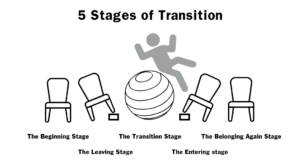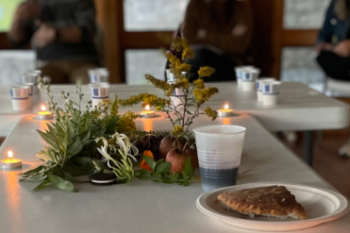Everything is Changing: The Five Stages of Transition
Dr. Robert Hull, Professor Emeritus of New Testament, used to give incoming students this advice, “Live your life here while you are here.” This is good and helpful advice, but it is also hard to do. When we enter a state of transition—especially a new stage in life—we cling to what is comfortable, known, and familiar. We already have a way of doing things, we already have our friends, and we already have a way of being in the world. And when we enter something new, all of this is challenged.
When I started my doctoral program, I was undergoing three major transitions at once. I was newly married, we were moving to a new state, and I was starting a PhD Program. During my school’s orientation I heard a talk from Dr. Marilyn Elliott using research from Sociologist David C. Pollock. He used to help the U.S. State Department transition its employees back into the U.S.
Elliott’s talk on transition was helpful because it gave us language to understand transition and addressed how to do the work of transition well. She began by noting that we live in constant transition and change. Sociologists call this state semi-permanent transitionality. We are constantly in the process of moving or changing from one state, condition, phase, situation, experience to another—and these changes and transitions are only happening more rapidly.
Some changes we have no control over. Our bodies grow and age, technology updates constantly and the world around us fluctuates without end. However, when we do have control, generally, people choose change for two reasons: pain or progress. If we experience enough pain or discomfort in a particular situation that is bad enough, we try to change that circumstance. Or if we can imagine something that will lead to progress for ourselves, the hope of that good thing can lead us to make a change. We often make decisions to change because of a combination of these two things: the pain of our present experience and our desire for progress.
So how do we change and transition well?
When talking with new students at orientation I illustrate this by using four chairs and a large exercise ball. The first chair before students is stable. The second chair has some books under one leg. The third “chair”, in the center, is a large exercise ball. The fourth chair has more books under one leg and the final fifth chair is stable again. This obstacle course is spaced out in front of students. It is a lot of fun to call for volunteers and watch people try to figure out how to cross the chairs of varying stability. I ask them to navigate the transition obstacle course without touching the ground and I check in at each stage to ask how they are feeling. Afterwards, we talk about the obstacle course as a way of understanding each stage of transition.
I tell them, “Your old life is on one side of the obstacle course and your new life is on the other side. Now this applies to seminary, but it also applies to any transition with work, family, moving and many other of life’s transitions.”
These chairs represent the five stages of transition. When we move to a new place or start something new, we often think that’s it. We’ve arrived! Here is our new life! But we have not actually started yet. Our old life still has a hold on us because we have not yet journeyed through transition. If you want to enter your new life you have to go through the journey of transition. You cannot enter your new life until you do. It is not automatic, and it takes work.
Stage 0: Before We Enter a Transition
In the before stage, you feel settled. You are present oriented. You know how to get your needs met. You know how to get help and you are in a position to help others. You know where to get the best coffee, food, and dessert when you have friends or family come to visit. You are active and important to your community, and you are content. Your life here is largely automatic—you drive to the store or home, and you don’t even think about the turns. And when you get to your favorite grocery store you know where everything is located.
You have feelings of inclusion, responsibility, intimacy, affirmation, you feel secure, and you feel safe. If you left, your community would miss you. Yet, you have decided to make a change. Maybe it’s seminary or the decision to get married or start a new job. But now you are moving forward.
Stage 1: The Beginning Stage (The First Chair)
You’ve just decided to make a change, and you are thrilled about it. The first stage we enter is exciting and filled with rosy ideals. There is celebration. You feel good about it. Everything is awesome and there are no problems. Learning biblical Hebrew is going to be fun and exciting. All the reading you have to do is going to be amazing and life changing. And you’re going to love every minute of seminary!
Here, you have shifted your focus temporarily to a future oriented state and have let go of your present orientation to some extent. And then you start to see and experience the choice you made, and it may be a little different than what you thought it would be.
Stage 2: The Leaving Stage (The Unstable Second Chair)
It starts to settle in that you have made a change. You are leaving the comfort that you have known for the unknown. You thought you would begin your new life right away, but instead you are on the wobbly chair. And suddenly you feel deeply unsettled, unsteady, you feel distant, maybe resentment creeps in. You are concerned you won’t measure up. You compare yourself to your peers and think, “I didn’t go there or do that or have that experience or that knowledge.” Maybe you even start to believe that you’re not going to succeed. You begin to sense that this place may cause you to change in ways you did not expect. You do not know how to get your needs met and worse you do not know who to trust. You may still have some excitement, but it is mixed with uncertainty.
In this new community, you are on the outside looking in. And that’s okay for now. You are not yet essential to them. But you will be. Your gifts, your personalities, and your life is going to determine what our community looks like, thinks like, and acts like. But in the beginning, you do not yet realize how important you are to this community. So, you have to keep going.
As we continue through transition, we reach the middle of the journey. And it is quite the messy middle. Or to be more dramatic, it may feel like the dark night of the soul. Enter “the Ball.”
Stage 3: The Transition Stage (The Exercise Ball)
This stage is where you start to shed the old life and begin to take on the new one. This is the stage where the unsettled feelings turn into uncertainty, instability, and where we come face to face with our grief. It feels like chaos. We tend to exaggerate our concerns and our behavior changes. We might change from bubbly and outgoing to inward and shy or vice-versa. We really face the ambiguity of who we are and what we have done.
This is the stage where you want to go home. You want to leave. And some people do. They refuse to do the work of transition. They think, “I hate this place,” or “this isn’t working for me,” or if they’re brutally honest they might say “God isn’t here,” or “I’m not actually called to this” or plainly they might feel something is just wrong. Now, none of this is true, they are just on the ball! They are experiencing the chaos of instability on the exercise ball and they are in the middle of journey through transition.
This is a tricky moment because we think this is the new life we have chosen. But we’re actually just in the messy middle. We are not yet at the new life. It’s the experience of being on the ball, the unsettled chaos. And this is transition. We are in the middle between the old life and the new life. But this is not where you will stay. You don’t live on the ball—some may stay longer than others, some might only experience it for a moment, but you never stay there.
Moving on through the messy middle will look different for everyone. But sharing your story and learning other’s stories is the first step. It is one thing to know your community and another for your community to know you. To transition well, we start to become known, and we start to know others. But you have to share the pain of your story as well. The not so fun parts of your story. The ugly parts, the painful parts and the parts you want to hide. But as you journey with your new community and they journey with you, those parts of your story become known.
This part of the transition is the hardest. We ask, “What if I fail? Will people still love me?” and other hard questions. When you are in this stage, ask for help. There are resources all around us in the new community you are in. Sign up for a mentor with the MRC, find a good counselor, or join a small group at church. Ultimately, we get through it by actually doing what Dr. Hull called us to do. Live here. Be present. Acknowledge the chaos and learn to accept it. Recognize the difficulty of the moment and face it. Lean in. Welcome new people into your life. Look for moments of grace. And it is crucially important to be gentle with yourself, your family, and to others around you. Recognize you are in transition. You are on the ball. You are in the chaos and only when you accept that, can you then move on to the next stage.
Stage 4: The Entering stage (The Second Unstable Chair)
You have started to acknowledge that your life is changing, and you choose to become a part of the community. You adapt and accept the new culture’s language, customs, norms, values, and way of life. You begin to feel more comfortable and find a bit more balance. What was all new and chaotic is starting to become familiar. With some stability regained you start to reach out and help others. You are making new friends, learning new ways, and you start to take calculated risks. You are learning now to take care of yourself and get your needs met in this new area. You appreciate the differences you see in your peers, and you appreciate the experiences and knowledge you bring to the conversations. You are building confidence and adapting to your new environment. You are entering your new life.
Stage 5: The Belonging Again Stage (The Final Stable Chair)
You are now an essential part of our community. You seamlessly navigate your life, things become automatic again. You know how to get your needs met. You start planning for friends and family to come visit you in your new life because you know where to get the best coffee, food, and dessert. You are in community again, and you are settled and content in your new environment. You know what’s happening in your community and your community knows you because your presence matters here.
Your life begins to be automatic again—you drive to church, or the store and you don’t even think about the turns. And when you get to the grocery store you know where everything is again! You can give and receive help without an issue. You now feel a sense of inclusion again, you are known, loved, and in a position of respect and honor in our community. You feel affirmed, secure, and safe. You are now present oriented in your new life and feel settled. You understand now why God has called you here.
The Benefits of Transition
Times of transition hold a unique set of benefits. This can be a time where you can create new habits and rhythms of life. When our automatic lives are interrupted, we have the initiative to start new things. This is one of those moments. A chance to restructure parts of yourself. Try new spiritual practices. To reconstruct parts of your life and your identity. Maybe you’ve never been a hiker, or a runner, or someone who works out, or cooks, or plays an instrument. You name it. Transitions offer you a chance to reshape or restart some parts of who you are.
A second benefit of transition is a chance to learn more about yourself. Learn what your true desires and needs are. During a transition continue to ask yourself, “what do I need to be okay today?” You might discover that transition is a great time to clarify your needs, desires, and a sense of your identity. When we are not so mechanical or automatic in our life we can slow down and examine the parts of us that rise to the surface.
At this point, I invite a student to walk over the transition obstacle course again. But this time I invite all the other students to stand around that student working through the course. We cheer them on. Hold the unstable chairs and their hands to guide them. Together we demonstrate the possibility of a community going through transition together. We must do the work of transition ourselves, but we cannot forget we have a community, even if it is new, to journey with us, support us, and cheer us on.
Finally, transition also offers us a chance to deepen our relationship with God and with the community of God. We so often feel an abandonment to God at a new level in transition. We may remember how to trust God for things we haven’t trusted God for in a long time. But when we follow God’s call and the Spirit’s leading for us and we truly lean into and love God in times of transition, then our relationship with God deepens. Our faith deepens. We may experience moments of complete chaos or uncertainty, but if we can just remember to trust God for our very breath that is enough. Because at Emmanuel, we are always reminded that God is with us—and that makes all the difference.
Aaron Woods is the Director of Seminary Admissions at Emmanuel Christian Seminary at Milligan. View Emmanuel’s Academic Programs page here.






